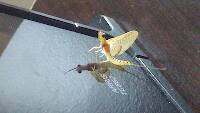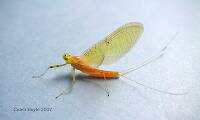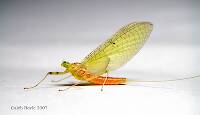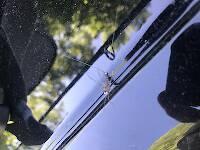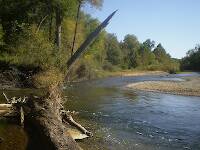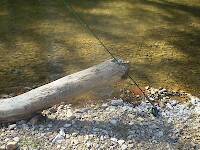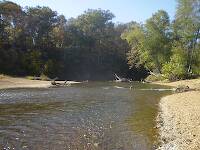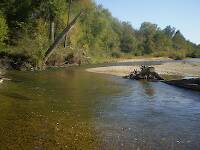
Salmonflies
Pteronarcys californica
The giant Salmonflies of the Western mountains are legendary for their proclivity to elicit consistent dry-fly action and ferocious strikes.
Featured on the forum

This specimen appears to be of the same species as this one collected in the same spot two months earlier. The identification of both is tentative. This one suffered some physical damage before being photographed, too, so the colors aren't totally natural. I was mostly photographing it to test out some new camera setting idea, which worked really well for a couple of closeups.

Troutnut is a project started in 2003 by salmonid ecologist Jason "Troutnut" Neuswanger to help anglers and
fly tyers unabashedly embrace the entomological side of the sport. Learn more about Troutnut or
support the project for an enhanced experience here.
Lastchance on Jun 27, 2009June 27th, 2009, 1:58 am EDT
There is a Little White May Fly Hatch (size 28) on the Little Juniata River in Pennsylvania. Question: What time of day does this happen and how do you identify them? Do they look like tiny pieces of white fuzz? I read on the site here that they occur during the trico hatch. I've seen these things floating through the air and they always remind me a white fuzz. Is that them?
Taxon on Jun 27, 2009June 27th, 2009, 3:53 am EDT
GONZO on Jun 27, 2009June 27th, 2009, 4:04 am EDT
Hi Bruce,
The Little J mayflies you mention are caenids (probably Caenis). They usually emerge in the evening in slow water, typically in areas with some combination of silt and weeds. The molt to the spinner stage occurs shortly after emergence.
They are distinctive little mayflies and easy to identify to family. Sometimes called "Broadwings" in Europe, they have broad whitish wings with a dark leading edge and few crossveins. They are also dipterous (no hindwings) and have three tails. The abdomen is usually whitish with a darker (brownish) thorax. Unlike most mayflies, they have the habit of resting with the wings outspread (spent) rather than upright.
The morning Tricos and the large evening White Flies (Ephoron) are usually much more important trout feeding opportunities at that time of the season, but carrying a few caenid imitations might be useful on occasion. From an imitation standpoint, I would recommend a synthetic Comparadun-style wing for both duns and spinners. Although the tails are longer in the spinner stage (especially the males), one pattern can suffice for both, and the Comparadun wing is easier to see than spent or semi-spent wings.
PS--Your "white fuzz" description made me think of pale midges, but I think Roger's suggestion is more likely.
The Little J mayflies you mention are caenids (probably Caenis). They usually emerge in the evening in slow water, typically in areas with some combination of silt and weeds. The molt to the spinner stage occurs shortly after emergence.
They are distinctive little mayflies and easy to identify to family. Sometimes called "Broadwings" in Europe, they have broad whitish wings with a dark leading edge and few crossveins. They are also dipterous (no hindwings) and have three tails. The abdomen is usually whitish with a darker (brownish) thorax. Unlike most mayflies, they have the habit of resting with the wings outspread (spent) rather than upright.
The morning Tricos and the large evening White Flies (Ephoron) are usually much more important trout feeding opportunities at that time of the season, but carrying a few caenid imitations might be useful on occasion. From an imitation standpoint, I would recommend a synthetic Comparadun-style wing for both duns and spinners. Although the tails are longer in the spinner stage (especially the males), one pattern can suffice for both, and the Comparadun wing is easier to see than spent or semi-spent wings.
PS--Your "white fuzz" description made me think of pale midges, but I think Roger's suggestion is more likely.
Troutnut on Jun 27, 2009June 27th, 2009, 8:02 am EDT
Taxon, thanks for that aphid link! I saw one of those a few years ago and was completely baffled by it. I hadn't found another one since, so I didn't get the chance to mess with it once I learned my bugs.
If they're really mayflies, Gonzo's probably right, but if you're sure about the little white fuzzball and not so sure about the mayfly part, I bet it's Taxon's bug.
If they're really mayflies, Gonzo's probably right, but if you're sure about the little white fuzzball and not so sure about the mayfly part, I bet it's Taxon's bug.
Jason Neuswanger, Ph.D.
Troutnut and salmonid ecologist
Troutnut and salmonid ecologist
Lastchance on Jun 28, 2009June 28th, 2009, 12:51 pm EDT
Caenis. I forgot about "The Angler's Curse."
Woolly Aphid. I never ceased to be amazed by you guys on this site. For years I've seen that Woolly Aphid and never had a clue.
Thanks,
Bruce
Woolly Aphid. I never ceased to be amazed by you guys on this site. For years I've seen that Woolly Aphid and never had a clue.
Thanks,
Bruce
SlateDrake9 on Aug 1, 2009August 1st, 2009, 10:15 am EDT
woolly aphid huh? I had a major "hatch" of these things in my back yard for a few weeks last summer. I though they were insects with some sort of fungus growing on them. Learn something new every day.
Fishing with bait is like swearing in church.
-- Slate Drake
-- Slate Drake
Taxon on Aug 1, 2009August 1st, 2009, 11:58 am EDT
I though they were insects with some sort of fungus growing on them.
B.J.-
As I recall, it's actually secreted wax.
Quick Reply
Related Discussions
Topic
Replies
Last Reply
2
Jul 9, 2018
by Martinlf
by Martinlf




